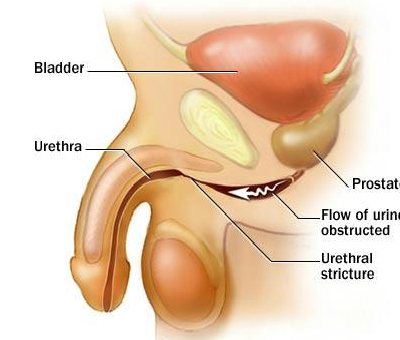The main function of urethra in both female and males was to pass urine outside from the body. This thin tube may also have an vital role in ejaculation in men. When a scar occurs from swelling, injury or infection blocks or slows down the flow of the urine in this tube, it is termed as urethral stricture. Some people may feel pain with this urethral stricture. The anterior urethra is the part of the urethra from the tip of the penis to just prior to the prostate.
An anterior urethral stricture is a scar that develops on the urethral epithelium (the urethra’s outside layer of cells) and usually extends into the underlying corpus spongiosum (this is a column of erectile tissue that will surrounds the urethra). The scar is collection of dense collagen and fibroblasts and thus contracts in all the directions, shortening the urethral length and also narrows the diameter of the urethra. Strictures usually asymptomatic until the size of urethra tube is below a certain size.

CAUSES:
generally in most cases it is asymptomatic. In adults, urethral strictures most often casues due to injury from a fall onto the scrotum or perineum, prostate surgery, kidney stone removal, urinary catheterization, other surgical tools. Common causes like
-
Trauma to the urethra
-
Infection such as a sexually transmitted disease
-
Damage caused from surgical tools
-
Conditions that may causes swelling
SYMPTOMS:
When a stricture is narrow enough to decrease the urine flow, patients will have symptoms. Problems with urinating, swelling or infections of the prostate, may occur. Severe blockage that lasts a long time and that will damage the kidney’s function.
Some signs of Stricture :
-
Bloody or dark urine
-
Urine stream spraying
-
Blood in semen
-
Pain with urinating, abdominal pain, urethral leaking
-
Slow or decreased urine stream
-
Urinary tract infections in men, swelling of the penis, loss of bladder control.
DIAGNOSIS:
There are several diagnostic tests to conclude if you have a urethral stricture that may includes:
-
Physical exam
-
Urethral imaging (X-rays or ultrasound)
-
Urethroscopy (to see the inside of the urethra)
-
Retrograde urethrogram.
To prevent anterior urethral stricture care should be taken such as:
To avoid injury to the urethra and pelvis and be careful with self-catheterization, avoid sexually transmitted infections.

